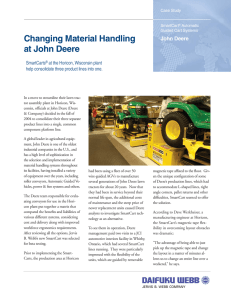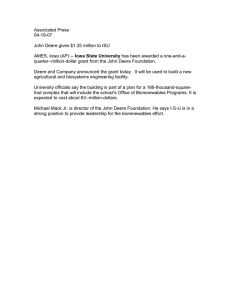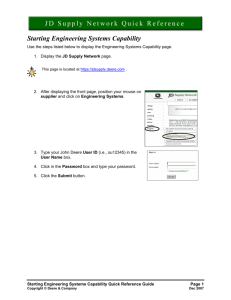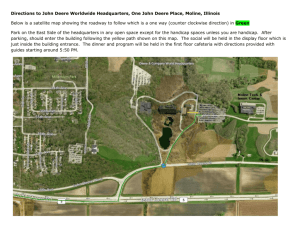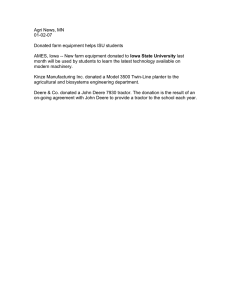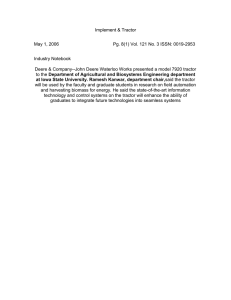Changing Material Handling at John Deere
advertisement
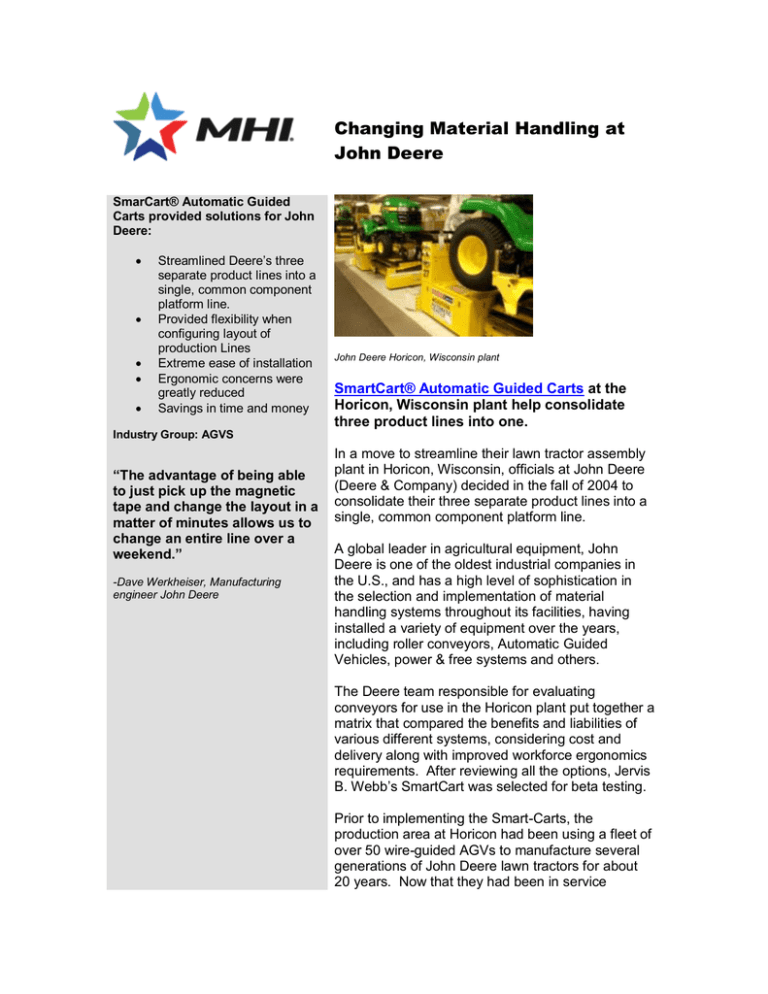
Changing Material Handling at John Deere SmarCart® Automatic Guided Carts provided solutions for John Deere: Streamlined Deere’s three separate product lines into a single, common component platform line. Provided flexibility when configuring layout of production Lines Extreme ease of installation Ergonomic concerns were greatly reduced Savings in time and money John Deere Horicon, Wisconsin plant SmartCart® Automatic Guided Carts at the Horicon, Wisconsin plant help consolidate three product lines into one. Industry Group: AGVS “The advantage of being able to just pick up the magnetic tape and change the layout in a matter of minutes allows us to change an entire line over a weekend.” -Dave Werkheiser, Manufacturing engineer John Deere In a move to streamline their lawn tractor assembly plant in Horicon, Wisconsin, officials at John Deere (Deere & Company) decided in the fall of 2004 to consolidate their three separate product lines into a single, common component platform line. A global leader in agricultural equipment, John Deere is one of the oldest industrial companies in the U.S., and has a high level of sophistication in the selection and implementation of material handling systems throughout its facilities, having installed a variety of equipment over the years, including roller conveyors, Automatic Guided Vehicles, power & free systems and others. The Deere team responsible for evaluating conveyors for use in the Horicon plant put together a matrix that compared the benefits and liabilities of various different systems, considering cost and delivery along with improved workforce ergonomics requirements. After reviewing all the options, Jervis B. Webb’s SmartCart was selected for beta testing. Prior to implementing the Smart-Carts, the production area at Horicon had been using a fleet of over 50 wire-guided AGVs to manufacture several generations of John Deere lawn tractors for about 20 years. Now that they had been in service beyond their normal life span, the additional costs of maintenance and the steep price of newer replacement units caused Deere analysts to investigate SmartCart technology as an alternative. To see them in operation, Deer management paid two visits to a JCI automotive interiors facility in Whitby, Ontario, which had several SmartCart lines running. They were particularly impressed with the flexibility of the units, which are guided by removable magnetic tape affixed to the floor. Given the unique configuration of some of Deere’s production lines, which had to accommodate Lshaped lines, right angle corners, pallet returns and other difficulties, SmarCart seemed to offer the solution. According to Dave Werkheiser, a manufacturing engineer at Horicon, the SmartCart’s magnetic tape flexibility in overcoming layout obstacles was dramatic: “The advantage of being able to just pick up the magnetic tape and change the layout in a matter of minutes allows us to change an entire line over a weekend,” he says. In February of 2005, Deere ordered a single unit to test as a first step in receiving design approval to implement a production changeover at Horicon. Later, six additional carts were added to the prototype build and 56 more AGCs joined the mix during the summer. By the fall, final approval and acceptance testing had to take place before full production was undertaken. This included functional safety testing, component repair procedures and the setting up of in-and offline charging stations. When the SmartCart line installation was finally optimized and completed with 76 carts, other AGC features helped to streamline the Deere production line. Unlike the earlier AGVs that had trunnions to rotate the tractor bodies for access, the company had now mandated top-down assembly for ergonomic reasons. The SmartCart’s hydraulic lift capabilities made it possible for operators to tailor the cart height for individual operations─raising or lowering the tractor bodies to the proper height for optimum assembly operations. For the most part, Werkheiser says, all the ergonomic concerns were greatly reduced. As with any automation process, during the initial commissioning and debug phase a number of unexpected issues arose that had to be addressed: transponder signal misses, speed encoder problems, optical tracking blocking, and even a sticking button or two. Once noticed, and with the help of the Webb engineers, these glitches were resolved. Another concern was the assembly throughput, which planners desired to peg at a 9-second index between operations to achieve daily production shift volume targets. However, the distance between stations and the length of the carts, along with the suggested optical blocking distance between carts, made this difficult to achieve. Nevertheless, Werkheiser believes the SmartCarts were the best choice for the money and will eventually reach their goal. The company currently has 80 carts in use at the Horicon facility. In addition to the cart’s flexibility in making line modifications and the extreme ease of installation, Deere found further savings in time and money with the SmartCart high “up-time,” where cart battery recharging times can be significantly reduced by employing a short, in-line automatic “opportunity charge” during every production cycle. Since the AGCs have now been in operation for about a year in the Wisconsin plant, management officials from some of Deere’s other plants have visited Horicon to observe the units in action, and several have expressed strong interest in introducing SmartCart technology into their own facilities, when new budgets are being planned. As Dave Werkheiser tells it, “These things have peaked interest throughout the company. Many of the plants are looking for alternative solutions for their material handling systems, including those in our agricultural division. When you look at the bang for the buck, you can’t beat these SmartCarts.” Daifuku Webb 34375 West Twelve Mile Road 248-553-1000 Info@daifukuwebb.com www.daifukuwebb.com
